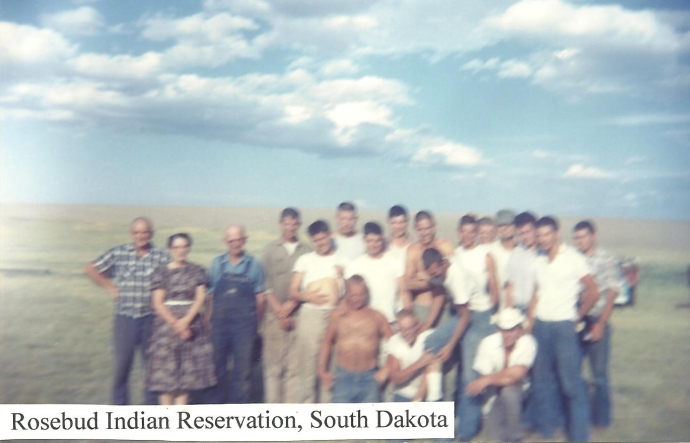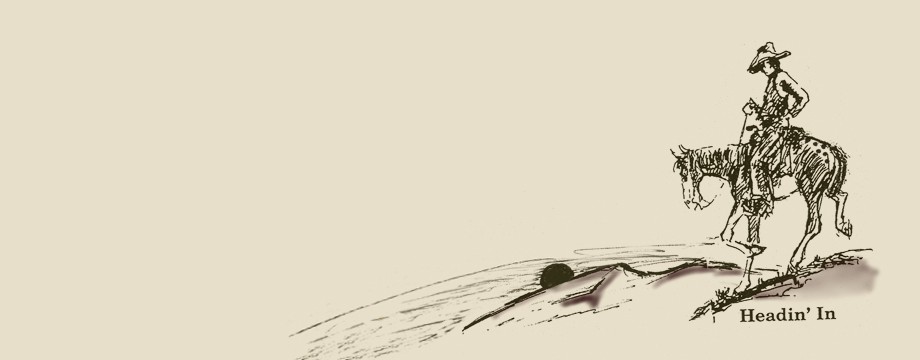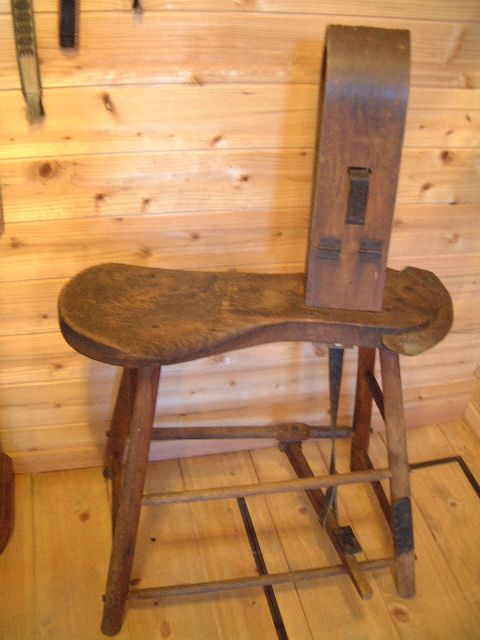It was the last of May in 1961. Twenty of us were following the harvest to make some money for college. In addition there was the supervisor, a mechanic, a gasoline truck driver, and a man and wife team that cooked our meals. The combine outfit was owned by Norman Hamm of Perry, Kansas. His family started the harvest crew in the 1940’s. It was the largest one-man owned outfit going. They called it Hammtown.

Lined up and ready to move out near Perryton, Texas. We could be loaded and ready to move in one hours time.
The harvest equipment consisted of ten new Massey Ferguson 95 self-propelled combines. They were transported on ten shop-made trailers pulled by ten 1959 Chevrolet two-ton trucks. Other support equipment included bunkhouses made out of truck and bus bodies. The diner was a bus body trailer complete with kitchen and a table that would seat fourteen at a time. It was pulled by a truck equipped with a water tank, generator and freezer and other supplies. The diner was supplied with electricity by the generator. All the equipment with the exception of the combines was painted light blue with white tops.
A shower house on wheels with a gas hot water heater and water supplied through a hose connected to the supply truck water tank kept us cleaned up. When we reached our next stop the hoses and drop cords were placed on the ground between trailers. The cooks had their own private trailer. They put in long days cooking for us right there where we camped in the fields. When on the road we ate in restaurants.

My bunk house, the Hammtown Sleeper. A converted school bus. Yes, that is me.
I was already an experienced and licensed truck driver. This put me behind the steering wheel of a truck pulling a combine at the start. Ten of us with combine and farm equipment experience were selected to operate the combines in the field. The combine operators also drove the truck-trailer rig hauling their assigned combines on the road. The other ten guys were assigned the job of driving the trucks hauling grain between the combine and the bins and commercial grain elevators. It was a different time, and I don’t think many of them held a commercial license. Back then it was called a chauffeur’s license.
We left Perry, Kansas early Memorial Day morning and headed south, first on the Kansas turnpike and then on the Oklahoma turnpike, and turned south toward Texas. We made camp somewhere in Oklahoma and arrived at the Waggoner Estates Ranch near Vernon, Texas late the next day. I had read of Dan Waggoner and the ranch’s place in history. At the time it was said to be the second largest ranch in the nation after the King Ranch. I believe it still holds that distinction.

The main entrance to the 55,000 acre Waggoner Estates Ranch. The Ranch’s famous Quarter Horse Stallion, Poco Bueno (little good one) is buried near the entrance.
The first couple days there we were putting the combines in order. Putting the belts on, lubricating and adjusting took up most of our time. We did not get paid for downtime but we got our bunk and meals furnished. The meals were outstanding.
The farmer in me noticed that the wheat was short and thin and certainly looked to me to be low yielding. I asked a ranch employee about it. He agreed, saying that it had been overgrazed during the winter. But, he explained that the management was not concerned, if it yielded enough to pay the combine bill. “After all,” he said, “The ranch makes its money from oil, horses and cattle.” The wheat got better as we got further into the fields.
We cut the wheat in blocks called a land, with five combines to a land. The largest continual field of wheat consisted of 2,200 acres. The Massey Ferguson model 95 combines were considered to be some of the best machines at the time. They were manufactured at Toronto, Canada. On a good day we could cut 750 acres total. We were told the combines cost around $7,500 each. The Chrysler six-cylinder engine was mounted sideways and located under the operator’s platform. Controls were mounted on the platform in front of the operator. The operator was seated on the platform out in the open. There were no air-conditioned cabs. Hats or caps and shirts were advised. Some of us went shirtless as time went on.
We were on the Wagner Ranch about ten days. It rained several times while we were there. Rain, of course, kept us out of the field for a day or two. The supervisors were good to us. They would load us in a truck and take us to town, to a movie, or in one case a county fair. We were warned that if we got into trouble, we were on our own. I drew $20.00 of my pay. That lasted me the entire trip.
Of the twenty harvesters, most were in their late teens or early twenties. The oldest harvester was a 29-year-old Englishman. The rumor was that he came over on a work or tourist visa. He wanted to see the real United States and somebody in Topeka sent him to Hammtown. Guiles was his first name. I have forgotten his last.
I mean no disrespect, but Guiles was a bit obtuse and most of the time downright obnoxious. He left us about halfway through the trip. He decided he wanted to see Denver, Colorado. They had sent him to the heartland with a bunch of fun-loving youngsters. He left us with a lot of stories to tell. I will share a few of the most humorous ones before I move on. I imagine he has a lot of harvester stories to tell, also.
Guiles was prematurely bald. His head was slick as an onion. The first day we told him he needed to get a straw hat. He had already told us what he thought of cowboys. He let us know in his customary rough language that he was not going to wear a “#@!% bloody cowboy hat.” Even though several of us wore them.
After a couple days of Texas sun, his old bald pate was as red as the combines we operated. We saw him slip a five dollar bill to the cooks and they brought him a straw hat back from their trip to town. He promptly punched the crease out of it, saying he did not want to look like a bloody cowboy.
In that level country, the roads were wide with shallow ditches on each side. Guiles, lacking experience, was assigned to drive a truck to the grain bins at the railroad. Of course, they drive on the left side of the road in England. Guiles just couldn’t bring himself to drive in the right lane. He would drive his truck down the middle of the road. Barreling down the middle, he yielded to no one.
One morning a deputy sheriff car showed up just after breakfast. A tall Texas lawman with his pants legs tucked into his cowboy boots unfolded himself from the car and stated he wanted to talk to us. We gathered around. He reached into the car and got his ten gallon cowboy hat and placed it squarely on his head. He wore a regular western-style gun belt with a holstered sixshooter, ivory grips and all. He put his eyes on every one of us before he spoke.
“Somebody from this outfit has been running people off the road. All your trucks look alike. They can’t tell which one it is, just yet. If he don’t stop it, he is going to get to see what the inside of my jail looks like.” We all knew who it was, and some were watching Guiles. He had an absolute look of horror on his face.
When Guiles pulled out of the field with his first load of wheat that morning, he had mastered the art of driving on the righthand side. I never heard of another complaint about his driving. I think his opinion of cowboys had changed, also.
We loaded up and pulled off the Waggoner Estates Ranch on June 10, turning north up the Texas panhandle at Childress. North of Childress we crossed the Prairie Dog Fork of the Red River, east of the lower end of the Palo Duro Canyon. On we rolled over the Salt or Middle Fork and then across the North Fork of the Red River. At normal intervals the combines and support equipment took up about a mile of highway.

On the Julius Johns farm at Johnson City, Kansas. The wheat is harvested and we are loaded up, ready to travel on.
We went through some country that I vowed I would visit again. The Canadian River area is some of the prettiest country I have seen. Yes, I have been back there to visit. Our destination was Perryton, Texas. We cut wheat southeast of there for several days. We broke camp and crossed into the Oklahoma panhandle. The caravan went through Liberal, Kansas and then west on to Hougoton. At Hougoton we turned north again and crossed the South Fork of the Cimarron River.
We setup camp near Johnson City and cut wheat around there and Ulysses. One of the wheat farmers we worked for at Johnson City had an airplane. We set up camp near the grass airstrip. One day the farmer’s two teenage daughters came out to the plane. It was obvious that they were dressed to go somewhere. A more adventurous youth struck up a conversation by asking them where they were going. They told him that the family was flying to Denver, Colorado to do some shopping. That was the closest big town. Denver would have been approximately 250 air miles.
The early settlers in that part of the country often referred to it as a sea of land. In 1961 it was mostly dry land farming. Now most of the farms are irrigated by sprinklers and ditch.
Having spent my early childhood on the great plains, the area was not entirely foreign to me. My Grandfather Ryan had owned land over the state line in Bent County, Colorado. In 1915 my maternal grandfather purchased a new steam engine and threshing machine in Amarillo, Texas. He moved north, threshing grain virtually over the same route we took almost 50 years later. Of course he threshed bundled and shocked wheat. He took several years to make the trip north. During the offseason he built houses and worked as a blacksmith around Liberal and several other towns. He finally traded his threshing rig for a blacksmith shop in Cheyenne County, Kansas.
On the move again, we crossed the the Arkansas River near Syracuse and stopped at Tribune. The cool weather and the rain had slowed the ripening process. We laid over a week at Tribune to wait for the wheat to ripen. In that dry expansive country each county seat had a park with a community swimming pool. We were allowed to set up our camp at the back of their park and use the swimming pool. The day we pulled in, there were only a few people at the pool. The next day it was swarming with girls. The word had got out that Hammtown was in town!

Jerry Parnell poses on the fender of his rig, at Tribune, Kansas.
Before I leave the subject of girls. I will tell of another humorous guy. His name was Doug Adams. He attended college in Arkansas and was a basketball referee on the side. He was a cut-up, with a gimmick he used. He would approach girls, on a street corner, in a restaurant or store. He would say in his best syrupy Arkansas drawl, “Excuse me ma’am. Do you know Doug Adams?”
Almost always they answered sincerely, “No, I don’t think I do.”
He would stick out his hand and say, “How would you like to meet him?” He always got a laugh and sometimes they actually shook hands.
I have forgotten most of my harvest friend’s names. I wish I had written all of them down. But, I remember the name Doug Adams.
We were of many locations and origins. I remember one youngster hired along the way. He was a replacement for a grain-hauler that had quit. He was probably 17 or 18. The young man was of very small stature. He wore a leather jacket with the picture of a wolf’s head painted on the back. He was asked by one prankster about the picture. He explained proudly that it was the symbol of the gang he belonged to. It was called the Wolf Pack. His tormenter said, “You don’t look like a wolf. You look more like a coyote to me. I am just going to call you Coyote!” The nickname stuck. Each time one of them called him Coyote he would get mad and want to fight. The little guy could not fight his way out of the proverbial wet paper sack.
One day I decided to intervene. I stepped in between and told them that it was time to leave him alone. I explained that he was like the rest of us, there because he wanted or needed a job. The same guy that named him piped up, “Listen to Ryan preaching a sermon. I reckon we should just call him Deacon.” For the rest of the tour, some called me Deacon, but they left the little feller alone.

A shirtless Walt poses with his rig, the number 10 truck and combine, somewhere in Kansas.
Next, we continued north across both branches of the Smokey Hill River and cut wheat east of Mt. Sunflower. It is not a mountain. It is just a rise in the prairie. It is the highest elevation in Kansas. We turned east at Goodland and went near Oberlin. After cutting wheat there, we went north into Nebraska. Chappell on the south side of the Platte River was our next harvest stop. We cut on a farm west of Chappell in the Platte River bottoms.
Again, along the Sundown Trail we touch a bit of history: As our combine caravan crossed the main street of Chappell, Nebraska that July day in 1961, furniture store owner Dick Cabela was starting a fishing lure mail-order business just down the street… It is one of those, wish-I-had-thought-of-that moments.
The Sand Hills rose up on the north side of the Platte. Each morning as we sat on our combines waiting to start, we would watch a herd of antelope go to water. They would walk single file down a path out of the hills and proceed to a windmill supplied stock watering tank. They would mill around the tank until we fired up the combines. When the combines roared into action they would run for the hills.
The river bottom area had an abundance of deer and other wild game. To protect their fawns from the coyotes, the does had hidden them out in the wheat. The older fawns would jump up and run, but the very young ones would lay there and let us run over them. We learned to watch for them and jerk the header bar control up as we passed over, to spare them and leave some cover.
From Chappell we went to Lodgepole. When we finished at Lodgepole we traveled through the Nebraska Sand Hills. At Valentine we crossed over into South Dakota. We finished the season cutting wheat on the Rosebud Indian Reservation. Normally the outfit would have went on into North Dakota and Montana, but it had been a poor crop year in those areas. We turned Hammtown south and journeyed home a month early.
Hammtown no longer exists. They ceased the harvest operation several years ago. Harvest 1961, remains a cherished memory along the Sundown Trail.

We pose for a group picture in South Dakota, before heading home. The man and lady on the left kept us fed. The gentleman in overalls was the mechanic. He could repair or make anything for the machines, right in the field. Doug Adams is showing the camera that he wears socks. I am the one wearing the hat. I wish I had all their names.













